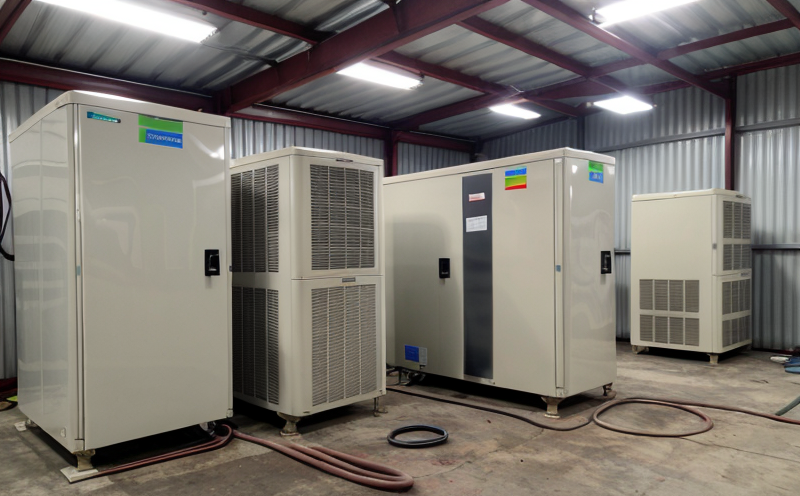ASTM D1945 Determination of Refrigerant Composition
The ASTM D1945 standard provides a method to determine the refrigerant composition in HVAC systems. This service is critical for ensuring system efficiency, compliance with environmental regulations, and maintaining optimal performance over time. Quality managers, R&D engineers, and procurement professionals rely on this test to verify that their HVAC equipment meets both industry standards and customer specifications.
The process involves sampling the refrigerant from the HVAC system and analyzing it using gas chromatography (GC). This method allows for precise quantification of various components within the refrigerant mixture. The results are then used to assess system integrity, identify potential leaks, and evaluate overall efficiency. Compliance officers benefit greatly from this service as it helps them stay ahead of regulatory changes related to refrigerants.
Proper sampling techniques are crucial in obtaining accurate results. Specimens must be collected under controlled conditions to minimize contamination or loss of volatile compounds. Once sampled, the refrigerant is introduced into a GC instrument where each component can be separated based on its boiling point and identified through mass spectrometry.
The accuracy of these determinations directly impacts the longevity and effectiveness of HVAC systems. By identifying any discrepancies early on, corrective actions can be taken before significant damage occurs, saving both time and money in the long run.
| Key Parameters | Description |
|---|---|
| Sampling Procedure | Properly performed to ensure accurate representation of the refrigerant mixture within the system. |
| Instrumentation | Gas Chromatograph coupled with Mass Spectrometer (GC-MS). |
| Data Interpretation | Analyzing peaks corresponding to different refrigerant components. |
| Reporting | Detailed report including composition percentages and potential issues detected. |
The ASTM D1945 standard ensures consistent results across multiple labs by providing clear guidelines for sample collection, analysis procedures, and interpretation of data. This consistency is vital when comparing findings between different facilities or over extended periods.
Understanding the composition of refrigerants in HVAC systems also aids R&D teams in developing more efficient and environmentally friendly alternatives. As regulations evolve, staying current with testing methods like ASTM D1945 allows companies to adapt swiftly without compromising quality.
Scope and Methodology
The scope of the ASTM D1945 Determination of Refrigerant Composition test includes analyzing the composition of refrigerants used in HVAC systems. This analysis helps ensure that the system operates efficiently and safely, complying with relevant standards such as ISO 5178 and EN378.
| Key Components | Description |
|---|---|
| Refrigerant Type | Varying types of refrigerants including HFCs, HCFCs, and CFCs are analyzed. |
| Sampling Points | Typically taken from condensers or evaporators depending on the system configuration. |
| Analysis Techniques | Gas Chromatography-Mass Spectrometry (GC-MS) for precise separation and identification of components. |
| Data Interpretation | Peak areas in GC chromatograms are integrated to determine individual component concentrations. |
The methodology involves several steps starting with proper sampling, followed by preparation of the sample for analysis using the GC-MS instrument. Once analyzed, the data is interpreted and reported back to the client along with recommendations if necessary. This process ensures that all aspects of the refrigerant composition are thoroughly examined.
It's important to note that this method can also help detect any leaks within the HVAC system by identifying unaccounted-for refrigerant losses. Such information is invaluable for maintenance planning and cost management.
Benefits
The ASTM D1945 Determination of Refrigerant Composition offers numerous advantages to those involved in maintaining HVAC systems. One primary benefit is enhanced system efficiency, which translates into lower operational costs and extended equipment lifespan. Regular testing helps prevent unexpected failures by identifying potential issues early on.
Compliance with environmental regulations becomes easier when using this service as it ensures that the correct refrigerants are being used according to current standards like ISO 5178 and EN378. This reduces the risk of fines or penalties associated with non-compliance.
R&D teams can leverage these test results to innovate new products or improve existing ones based on real-world performance data. For procurement officers, knowing exactly what they're purchasing ensures better decisions regarding supplier quality and product reliability.
Customer satisfaction improves significantly when HVAC systems operate optimally thanks to regular testing ensuring consistent performance levels across all units installed by the organization.
Use Cases and Application Examples
| Case Study 1: Industrial Facility | Description |
|---|---|
| An industrial facility found discrepancies between expected and actual refrigerant levels during routine maintenance. | Through ASTM D1945 testing, they discovered leaks in several key areas of their HVAC system. These findings allowed them to address the problem proactively rather than reactively, saving substantial repair costs. |
| Case Study 2: Residential Building Complex | A residential building complex was experiencing higher-than-expected energy consumption rates despite regular maintenance schedules. Testing revealed that some units were using outdated refrigerants not compliant with current standards. |
In another instance, a commercial property owner needed assurance regarding the environmental impact of their HVAC systems. By implementing ASTM D1945 testing, they could confirm compliance and make informed decisions about future upgrades or replacements.
The service is also beneficial for educational institutions looking to teach students about proper maintenance practices in real-world settings. It provides practical experience using advanced analytical techniques while emphasizing the importance of regulatory adherence.





